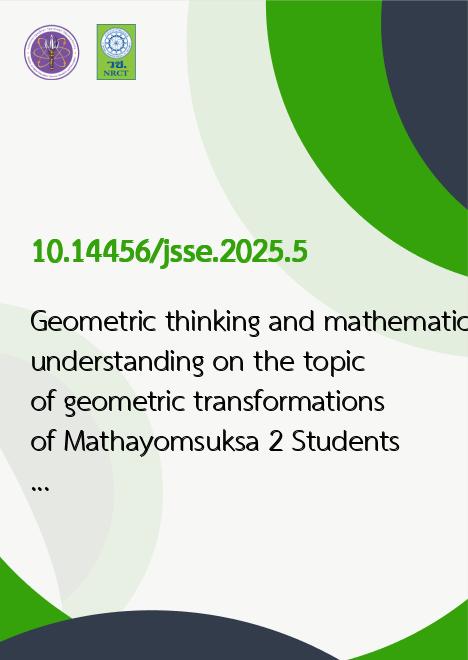
|
Geometric thinking and mathematical understanding on the topic of geometric transformations of Mathayomsuksa 2 Students using GeoGebra software |
|---|---|
| รหัสดีโอไอ | |
| Creator | Panadda Sangsrikaew |
| Title | Geometric thinking and mathematical understanding on the topic of geometric transformations of Mathayomsuksa 2 Students using GeoGebra software |
| Contributor | Nitikorn Laothaworn, Moeiwadee Butchamruan |
| Publisher | Faculty of Science, Ubon Ratchathani University |
| Publication Year | 2568 |
| Journal Title | Journal of Science and Science Education |
| Journal Vol. | 8 |
| Journal No. | 1 |
| Page no. | 42-56 |
| Keyword | Geometric thinking, Mathematical understanding, GeoGebra |
| URL Website | https://so04.tci-thaijo.org/index.php/JSSE/ |
| Website title | Journal of Science and Science Education |
| ISSN | ISSN 2697-410X |
| Abstract | This research aimed to 1)compare the geometric thinking on geometric transformations of Mathayomsuksa 2 students who received instruction using GeoGebra with a criterion of 75%, 2) compare the mathematical understanding of geometric transformations of Mathayomsuksa 2 students who received instruction using GeoGebra with a criterion of 75%, and 3) examine the attitudes of Mathayomsuksa 2 students after learning through GeoGebra. The sample used in this research consisted of 156 Mathayomsuksa 2 students from Anukoolnaree School, Kalasin Province, selected through simple random sampling. The research instruments included: Lesson plans on geometric transformations 12 lesson plans Geometric thinking and mathematical understanding tests Student attitude questionnaire Data were analyzed using basic statistical methods, including: Mean (X?), Standard deviation (S.D.), Percentage and t-test for one sample. The research findings revealed that the Geometric thinking of Mathayomsuksa 2 students who received instruction using GeoGebra was 81.33%, which was significantly higher than the 75% criterion at the .01 level. Additionally, students demonstrated geometric thinking at all levels above the 75% criterion, with statistical significance at the .01 level. The mathematical understanding of students who learned using GeoGebra was 82.81%, which was significantly higher than the 75% criterion at the .01 level, aligning with the research hypothesis. When analyzed by specific aspects, it was found that students had the highest level of mathematical understanding at the action level (84.78%), followed by the process level (83.33%), the cognitive structure level (82.85%), and the object level (80.29%), respectively. Students' attitudes were at the highest level overall (X? = 4.72, S.D. = 0.51). |